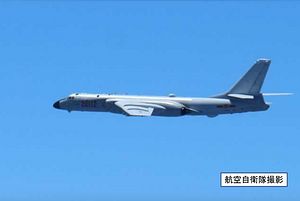The People’s Liberation Army Air Force (PLAAF) sent four Xian H-6K long-range bombers, one Shaanxi Y-8 electronic countermeasures aircraft, one Tupolev Tu-154MD electronic intelligence plane, and at least two Sukhoi Su-35 multirole fighter jets through international airspace between the Japanese islands of Okinawa and Miyako in the East China Sea on March 23 as part of a military exercise, Japan’s Ministry of Defense (MoD) said in a statement.
The Japan Air Self-Defense Force (JASDF) scrambled Mitsubishi F-15J all-weather air superiority fighters in response. According to the Japanese MoD, Japanese airspace was not violated. A PLAAF spokesperson said that the Chinese aircraft “carried out a real combat training mission in the West Pacific via the Miyako Strait,” in order to improve the PLAAF’s “high-sea combat ability.” Additionally, the spokesperson insisted that the exercise was in line with international law and practice.
At the same time, another group of PLAAF aircraft that included Su-35s and H-6Ks conducted a joint combat patrol in the South China Sea “practicing aerial maneuvers and strike tactics at sea,” the service said in a statement. It is only the second time that the PLAAF has sent its Su-35S (NATO reporting name: Flanker-E), an improved fourth generation, twin-engine, multirole fighter aircraft and the latest variant of Russia’s Flanker-series, to the South China Sea for combat drills.
As I noted in January, the Su-35S is one of the PLAAFs most advanced fighter jets. It “features an export-standard radar system — the Irbis-E passive-electronically scanned-array radar, capable of tracking up to 30 targets simultaneously and purportedly able to engage up to eight — an electronic warfare and communications suite, as well as a newly integrated receiver for the domestically-built BeiDou satellite navigation system.” China took delivery of 14 out of a total order of 24 Su-35s from Russia in late 2016 and 2017. The remaining ten aircraft are expected to be delivered this year.
The H-6K bombers participating in the combat drills in the South China Sea and Western Pacific were armed with air-launched cruise missiles, based on PLAAF images released to the public. The H-6K “can carry up to seven YJ-12 supersonic anti-ship missiles (six on wing pylons plus one in the bomb bay) or CJ-20 subsonic land-attack cruise missiles with an estimated range of 250 and 1,500 miles respectively,” I wrote elsewhere. However, the aircraft, a derivative of the Soviet-era Tupolov Tu-16 aircraft, lacks stealth capabilities.
As China is stepping up its military presence in the region, Japan is slated to deploy two Aegis Ashore batteries armed with SM-3 Block IIA (and SM-6 missiles) by 2023 at an estimated cost of $2 billion to defend the Japanese homeland against Beijing’s (and North Korea’s) growing ballistic and cruise missile arsenals. PLAAF bombers armed with nuclear-capable long-range cruise missiles are a particular concern for Tokyo.

































